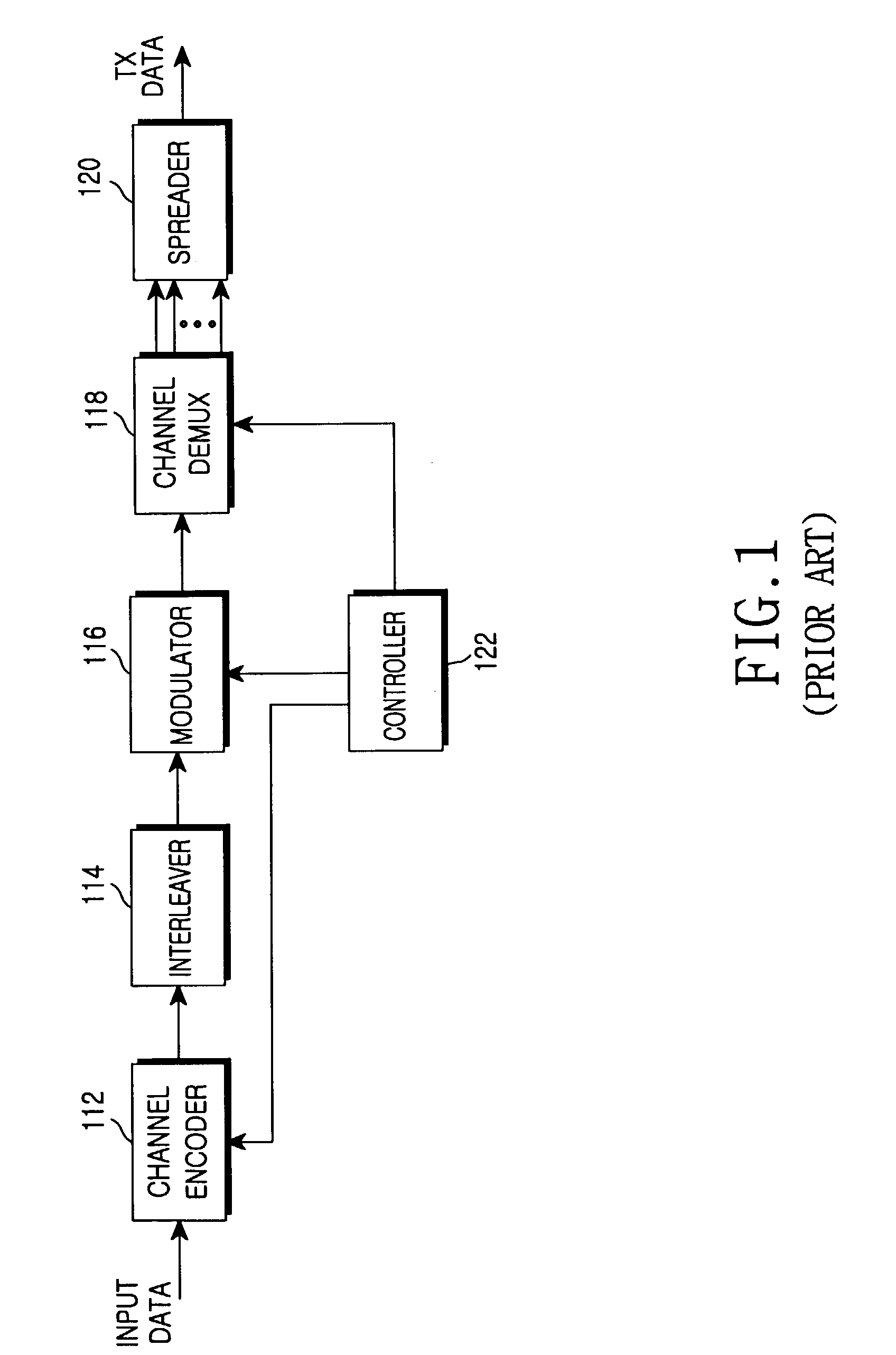Transceiver apparatus and method for efficient retransmission of high-speed packet data
a data transceiver and packet data technology, applied in the field of data transceiver apparatus and method in a cdma (code division multiple access) mobile communication system, can solve the problems of difficult to determine which technique is optimal for a given system, impedes a high-speed, high-quality radio data service, and difficult to adapt to the channel environment. achieve the effect of improving the performance of the radio communication system
- Summary
- Abstract
- Description
- Claims
- Application Information
AI Technical Summary
Benefits of technology
Problems solved by technology
Method used
Image
Examples
second embodiment
of Transmitter
[0066]FIG. 5 illustrates a structure of a transmitter for a CDMA mobile communication system according to another embodiment of the present invention. Like the embodiment shown in FIG. 4, FIG. 5 also shows only the elements arranged between the buffer and the modulator in the transmitter.
[0067]Referring to FIG. 5, coded bits generated by encoding input data at a mother coding rate of a turbo encoder (not shown) are stored in a buffer 502. The coded bits are properly punctured by a puncturer 504 according to information on a coding rate and a selected HARQ type, provided from a controller 520. The puncturer 504 uses a puncturing pattern for puncturing the coded bits according to the HARQ type. When the HARQ type is CC or PIR, an output of the puncturer 504 is comprised of a systematic sub-packet having only the systematic bits and a parity sub-packet having only the parity bits at each transmission. Here, when the HARQ type is CC, the parity sub-packet output from the p...
first embodiment
of Receiver
[0076]FIG. 6 illustrates a structure of a receiver corresponding to the transmitter of FIG. 5, according to an embodiment of the present invention. In FIG. 6, a despreader 602, a demodulator 606 and a controller 620 are provided with information on a coding rate, a modulation technique, a Walsh code used, a redundancy packet number, and the number of retransmissions over a downlink control channel, and the elements perform the following operations based on the provided information.
[0077]Referring to FIG. 6, a received data symbol, which was frequency-spread by the transmitter of FIG. 5 with multiple Walsh codes before being transmitted, is despread into a plurality of transmission symbol streams by a despreader 602 with the multiple Walsh codes used by the transmitter. The receiver can be provided with the multiple Walsh codes used in the transmitter based on Walsh code information signaled over a downlink channel. The transmission symbol streams despread by the despreade...
first embodiment (
1. First Embodiment (Coding Rate ½, PIR)
[0093]In the first embodiment, a coding rate is ½ and PIR is used as the HARQ. In addition, it is assumed that modulation techniques at initial transmission and retransmission are 16QAM and QPSK, respectively. Further, it is assumed that the number of Walsh codes used at retransmission is equal to the number of Walsh codes used at initial transmission.
[0094]In this embodiment, only three parity sub-packets will be taken into consideration, for the sake of convenience. In each table illustrated in FIGS. 7 to 11B, “O” means a sub-packet transmitted when a modulation technique at retransmission is identical to a modulation technique at retransmission, while “X” represents a sub-packet selected when a modulation technique is changed at retransmission according to an embodiment of the present invention.
[0095]FIG. 7 illustrates sub-packets that can be selected when a modulation technique is changed during retransmission in the retransmission mask se...
PUM
 Login to View More
Login to View More Abstract
Description
Claims
Application Information
 Login to View More
Login to View More - R&D
- Intellectual Property
- Life Sciences
- Materials
- Tech Scout
- Unparalleled Data Quality
- Higher Quality Content
- 60% Fewer Hallucinations
Browse by: Latest US Patents, China's latest patents, Technical Efficacy Thesaurus, Application Domain, Technology Topic, Popular Technical Reports.
© 2025 PatSnap. All rights reserved.Legal|Privacy policy|Modern Slavery Act Transparency Statement|Sitemap|About US| Contact US: help@patsnap.com



